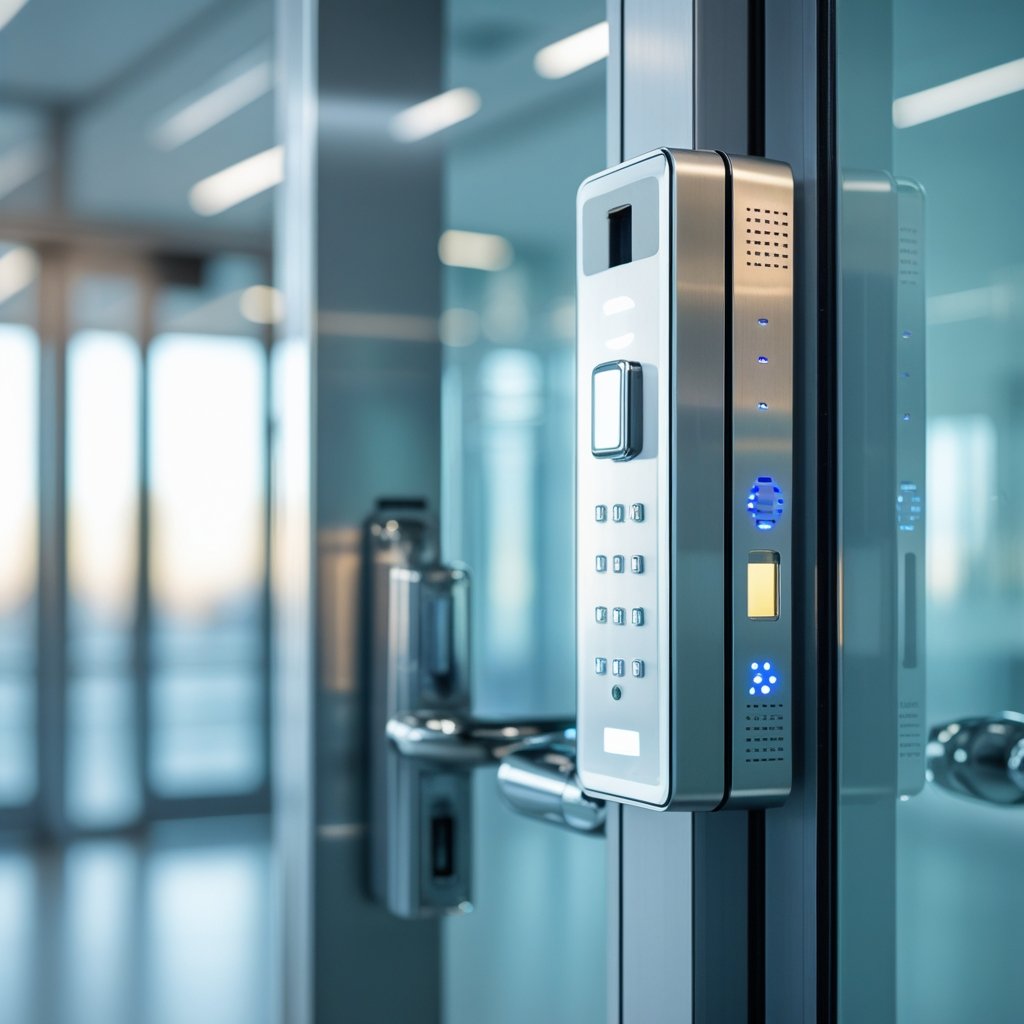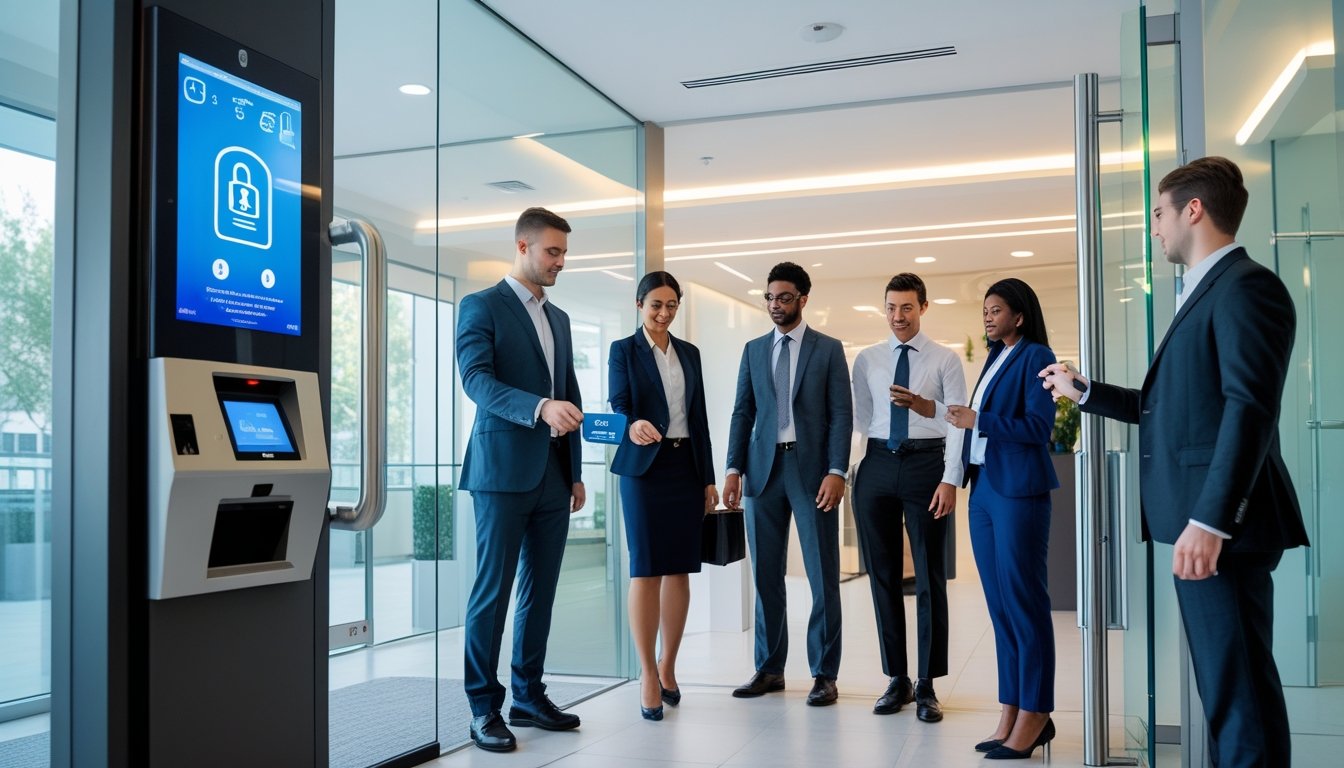In today’s ever-evolving workplace landscape, securing areas within your office is crucial for protecting both employees and assets. Door access control systems offer a modern solution to traditional locks, delivering enhanced security and operational efficiency tailored specifically for businesses. These systems allow you to manage who enters your office spaces, ensuring that only authorized personnel have access while maintaining a detailed record of entry times.
Selecting the right door access control system can be a strategic decision that impacts your office's security and productivity. With various technologies available, understanding the features and benefits of each option helps you choose a solution that aligns with your unique needs. By implementing an effective access control system, you not only protect your facilities but also streamline operations, making your office a safer and more efficient environment.
For businesses in the greater Houston area, investing in a reliable door access control system means prioritizing safety and peace of mind. In an age where security threats can emerge unexpectedly, being proactive about access management is essential for any office environment.
Types of Door Access Control Systems for Offices
Access control systems for offices enhance security and streamline entry. You can choose from various systems tailored to meet specific business needs, ensuring that only authorized personnel gain access to your facilities.
Card-Based Access Control
Card-based access control systems utilize smart cards, key fobs, or RFID cards for entry. Employees present their card to a reader at the door, which scans the card's data to grant or deny access.
This system is popular for its convenience and scalability. You can easily issue and deactivate cards, making it easy to manage employee turnover. In many cases, these systems also integrate with other security features, such as surveillance cameras.
Keypad and PIN Systems
Keypad and PIN systems require users to enter a numerical code to gain access. This method is straightforward and cost-effective for businesses.
You can set unique codes for different employees, allowing for individualized access management. The main advantage is that there is no physical card to lose or replace. However, security is reliant on users remembering their codes and keeping them confidential.
Biometric Authentication Methods
Biometric authentication systems employ unique biological characteristics—such as fingerprints, facial recognition, or iris scans—for access. These systems are gaining popularity due to their high level of security.
You benefit from improved accuracy and reduced risk of unauthorized access. Biometric systems can integrate with existing security infrastructure but may require additional investment. They can also handle multiple users efficiently, making them an excellent choice for high-traffic areas.
Choosing the right access control system involves evaluating the unique needs of your office and understanding the implications of each type.
Key Features of Door Access Control Systems
When implementing door access control systems in your office, focusing on their essential features can significantly enhance security and efficiency. Here are key features that you should consider.
Remote Management Capability
With remote management, you have the power to control access to your office from virtually anywhere. This feature enables you to monitor door status, grant or revoke access permissions, and receive real-time alerts.
Imagine being able to manage your access control system through a mobile app or a web portal. This flexibility can allow you to make adjustments on the fly, especially useful during emergencies or when staff changes occur.
Remote management also simplifies operations for multi-site businesses. You can oversee various locations from a centralized interface, ensuring consistent security protocols without needing to be physically present.
Audit Trails and Reporting
Audit trails are critical for tracking who accessed specific areas and when. This feature provides a detailed log of entries and exits, which can be invaluable for security investigations or compliance purposes.
You can generate reports that summarize access patterns over specific periods. Such insights help you identify irregularities or potential security threats, allowing for timely interventions.
The reporting capability also aids in ensuring compliance with industry regulations. By maintaining accurate records, you can demonstrate accountability in your security practices.
Integration with Office Security Systems
An effective door access control system should seamlessly integrate with your existing office security infrastructure. This assimilation enhances the overall security posture by unifying different elements like surveillance cameras, alarm systems, and visitor management solutions.
Integration allows for synchronized operations. For example, if an alarm is triggered, the access system can lock down specific doors automatically. This adds an extra layer of protection during critical situations.
Moreover, with integrated systems, you can manage everything from a single interface. This streamlines processes, reduces the complexity of managing multiple systems, and ensures cohesive security coverage across your premises.
Benefits of Implementing Access Control in Offices
Implementing an access control system in your office can significantly enhance security, streamline management, and provide flexibility in permissions. These systems not only protect your personnel and assets but also make visitor management more efficient.
Enhanced Security for Personnel and Assets
Access control systems provide robust security by ensuring that only authorized individuals can access specific areas. You can restrict entry to sensitive locations, such as server rooms or executive offices, reducing the risk of unauthorized access.
Real-time monitoring capabilities enable you to track movements and receive alerts for suspicious activities. Each entry attempt is logged, allowing for easy retrieval of data during security audits.
In the greater Houston area, employing these systems can help you safeguard valuable assets and maintain a safe working environment.
Flexible Access Permissions
With an access control system, you have the ability to set customized access permissions based on roles or departments. You can easily grant or revoke access as needed, ensuring that employees only enter areas relevant to their job functions.
This flexibility simplifies the process of onboarding new employees or managing temporary staff. You can predefine access rights for visitors, allowing them limited entry to specific areas, thereby enhancing overall office security.
By staying in control of who has access, you can adjust permissions quickly in response to changes in your workforce, improving security management.
Streamlined Visitor Management
Managing visitors can be cumbersome without a proper system in place. Access control systems allow you to facilitate efficient visitor management by pre-registering guests and issuing temporary access credentials.
You can automate the check-in process, ensuring that all visits are documented and monitored. This helps in tracking who is onsite at any given time, which is crucial for safety and security protocols.
In the greater Houston area, these systems contribute to a professional image while ensuring that your workspace remains secure and welcoming.
Choosing the Right Door Access Control Solution
Selecting the appropriate door access control solution is vital for enhancing security and operational efficiency in your office. Factors such as scalability, compatibility with existing systems, and vendor support play key roles in making an informed decision.
Scalability and Office Size Considerations
When choosing a door access control system, consider the size of your office and potential future growth. A scalable system allows you to easily add new users and access points as your business expands.
For small offices, basic keycard access might suffice, while larger organizations may require more advanced systems such as networked or cloud-based solutions. Look for solutions that offer flexibility in features and capacity to ensure it meets both current and future needs.
A thorough analysis of your office layout and employee count can help identify the right solution. Ensure that the system you choose can accommodate fluctuations in personnel, especially during peak seasons or expansions.
System Compatibility
The compatibility of the access control system with your existing infrastructure is crucial. Ensure the new system can integrate seamlessly with your current security measures, such as surveillance cameras or alarm systems.
When evaluating options, inquire about the compatibility with various hardware types like keycards, biometric systems, or mobile access solutions. It’s important to choose a system that can work within your existing framework without necessitating extensive modifications.
This will not only streamline the implementation process but also save you time and costs associated with training employees on new systems.
Vendor Support and Installation
Finally, consider the level of vendor support available for the access control system. A reliable vendor should provide comprehensive installation services and ongoing support to ensure the system operates efficiently.
Check for local vendors in the greater Houston area that can offer personalized service. Evaluate their response times, maintenance options, and training resources.
A vendor who understands your local security needs will help facilitate a smoother implementation. This partnership can ensure that you receive ongoing assistance as you adapt to the system and its features.
Best Practices for Office Access Control Management
Implementing effective management practices for office access control is essential. Focus on keeping your system updated, training employees on policies, and conducting security audits. These steps ensure a secure environment and reduce vulnerabilities.
Regular System Updates
Maintaining up-to-date access control systems is critical for security. Regular updates protect against vulnerabilities that could be exploited by unauthorized users.
Schedule updates for software and hardware components, addressing any security patches from your system provider.
If your system supports automation, enable automatic updates to minimize manual intervention. Regular review of system settings can also ensure compliance. Keeping your system current not only enhances security but also improves operational efficiency.
Employee Training on Access Policies
Training your staff on access policies is vital for maintaining security protocols. Inform employees about access rights, including who can enter specific areas and under what circumstances.
Regular training sessions help ensure that employees understand their roles in maintaining security. Use real-life examples to illustrate potential risks associated with unauthorized access.
It’s also beneficial to provide written guidelines, which employees can refer to when needed. Frequent refreshers on policies can help keep security a top priority among your team.
Periodic Security Audits
Conducting periodic security audits enables you to assess the effectiveness of your access control measures. These audits help identify potential weaknesses in your current system, allowing you to take proactive measures.
Schedule these evaluations at least annually, or more frequently if your office experiences changes in personnel or operations. During an audit, review access logs, check employee compliance with training, and ensure physical security measures are adequate.
Utilizing a checklist during the audit can streamline the process, ensuring no aspect goes overlooked. Address findings quickly to enhance security and protect your workplace.
Frequently Asked Questions
When considering a door access control system for your office, several important factors come into play. Understanding these elements can help you make informed choices that enhance your workplace security and efficiency.
What factors should be considered when choosing an office door access control system?
You should assess the size of your office, the number of access points, and the security needs of your business. Consider the types of credentials you want to use, such as key cards, biometrics, or mobile access. It’s also crucial to evaluate scalability and the system's ability to integrate with existing technologies.
How do biometric access control systems enhance office security?
Biometric systems offer a high level of security by using unique physical characteristics, such as fingerprints or facial recognition, for authentication. This significantly reduces the risk of unauthorized access. The reliability of biometric data makes it harder for individuals to share access credentials, enhancing overall security.
What are the pros and cons of using magnetic locks for office access control?
Magnetic locks provide a strong and secure option for access control, often used in conjunction with an access control system. They are relatively easy to install and maintain. However, they may have drawbacks such as dependency on a power source and potential vulnerabilities to forced entry if not paired with additional security measures.
How can access control systems be integrated with other security systems in an office environment?
Integration can improve security management by allowing you to synchronize access control with alarms, surveillance cameras, and even fire safety systems. This interconnectedness enhances real-time monitoring and response capabilities, streamlining the overall security framework in your office.
What is the typical cost range for installing an access control system in an office?
The cost can vary significantly based on the complexity of the system, the number of doors, and the specific technology used. Generally, you can expect to spend between $3,000 to $10,000 for a comprehensive system, depending on your office's size and specific requirements.
How often should an office access control system be updated or maintained?
Regular maintenance is essential for ensuring optimal operation. You should conduct routine checks at least once a year, and immediately address any issues that arise. Updating software and firmware as needed is crucial to protect against potential security vulnerabilities and to enhance system functionality.
.svg)



.svg)


.svg)



